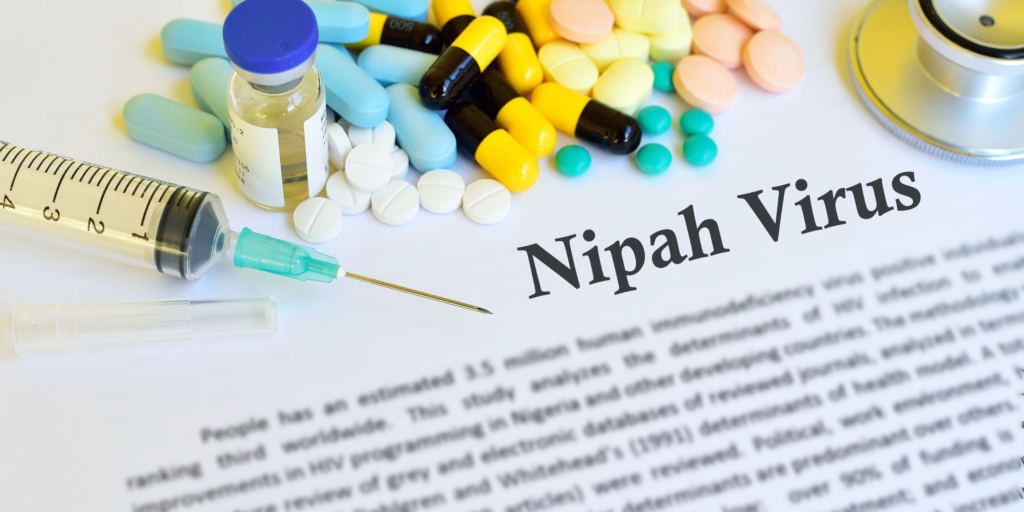WHAT IS NIPAH VIRUS?
The “Nipah” virus is a zoonotic (animal-based) virus that can cause several respiratory and neurological diseases in both animals and humans1. The virus was first identified in Malaysia in 1998, when an outbreak occurred among pig farmers and people in close contact with them. Since then, there have been several outbreaks of Nipah virus in various parts of the world, including India, Bangladesh, and Singapore.
Nipah virus is primarily transmitted to humans through direct contact with infected animals, such as fruit bats, pigs, and horses, or through contact with contaminated materials, such as urine or feces. The virus can also be transmitted from person to person through close contact with infected bodily fluids.
Symptoms of Nipah virus infection can range from mild to severe, and can include fever, headache, muscle pain, vomiting, and neurological symptoms such as seizures and coma. The mortality rate of Nipah virus infection is estimated to be between 40% and 75%, depending on the outbreak and the population affected.
RECENT NIPAH VIRUS NEWS
In 2018, an outbreak of Nipah virus occurred in Kerala, India, which resulted in the death of 17 people2. The outbreak was contained through a combination of measures, including contact tracing, isolation of infected individuals, and public awareness campaigns. This outbreak highlighted the need for continued vigilance and preparedness in the face of emerging infectious diseases.
TREATMENT FOR NIPAH VIRUS
There is no specific treatment for Nipah virus infection, and supportive care is the mainstay of treatment3. This can include hydration, fever management, and management of neurological symptoms such as seizures. Ribavirin, an antiviral medication, has been used in some cases, but its effectiveness in treating Nipah virus infection is unclear.
TRANSMISSION
There are several ways through which a person can get infected with this potentially deadly virus, some of the most common ways of transmission is listed below4:
- If you come into direct contact with an infected animal like bats and pigs or their body fluids like saliva, urine, or blood then the chances of infection are high.
- Also, if you consume food contaminated by infected animals, the risk of infection is high.
- Similarly, if you come into close contact with an infected person or their body fluids like blood, urine, or saliva then there are chances of getting infected.
NIPAH VIRUS PREVENTION
Preventing Nipah virus infection requires a multi-pronged approach5. This includes:
- Avoiding contact with infected animals: People should avoid contact with animals that are known to be infected with Nipah virus, such as fruit bats, pigs, and horses.
- Proper hygiene: People should practice good hand hygiene and avoid touching their eyes, nose, and mouth with unwashed hands.
- Cooking and consuming food properly: People should ensure that food is cooked properly and should avoid consuming raw or partially cooked fruits or vegetables.
- Avoiding exposure to contaminated materials: People should avoid exposure to contaminated materials such as urine or feces from infected animals.
- Public awareness campaigns: Governments should run public awareness campaigns to educate people about the risks of Nipah virus infection and how to prevent it.
NIPAH VIRUS SPREAD IN THE US
As per the medical experts, people in the US are safe now, as the infection is limited to Asia where fruit bats live, but if we have learned anything from the recent COVID-19 outbreak, that these viruses can spread quickly and easily, and it’s always possible for the Nipah virus or any other infectious disease to potentially spread to new regions. It’s important for healthcare professionals and authorities to remain vigilant and take necessary precautions to prevent the spread of any infectious diseases.
Sources for Further Research
- Nipah Virus (NiV) Retrieved from: https://www.cdc.gov/vhf/nipah/index.html
- The next pandemic: Nipah virus? Retrieved from: https://www.gavi.org/vaccineswork/next-pandemic/nipah-virus
- Treatment Retrieved from: https://www.cdc.gov/vhf/nipah/treatment/index.html#:~:text=Treatment%20is%20limited%20to%20supportive,for%20treatment%20of%20NiV%20infections
- World Health Organization. (2018). Nipah virus. Retrieved from https://www.who.int/health-topics/nipah-virus#tab=tab_1
- Centers for Disease Control and Prevention. (2021). Nipah virus. Retrieved from https://www.cdc.gov/vhf/nipah/index.html
- Government of India Ministry of Health and Family Welfare. (2021). Nipah Virus Disease Outbreak in Kerala 2021. Retrieved from https://www.who.int/news-room/fact-sheets/detail/nipah-virus
- Looi, L. M., Chua, K. B., & Hooi, P. S. (2007). Epidemic Nipah encephalitis in Malaysia. Journal of Neurology, Neurosurgery & Psychiatry, 78(4), 401-403. doi: 10.1136/jnnp.2006.099630
- Chua, K. B., Bellini, W. J., Rota, P. A., Harcourt, B. H., Tamin, A., Lam, S. K., . . . Brian, D. A. (2000). Nipah virus: A recently emergent deadly paramyxovirus. Science, 288(5470), 1432-1435. doi: 10.1126/science.288.5470.1432
- Aditi and M. Shariff. Nipah virus disease: A review. Epidemiol Infect. 2019; 147: e95. Published online 2019 Feb 22. doi: 10.1017/S0950268819000086 Retrieved from: https://www.ncbi.nlm.nih.gov/pmc/articles/PMC6518547/
- Centers for Disease Control and Prevention. (2021). Prevention of Nipah Virus Infection. Retrieved from https://www.cdc.gov/vhf/nipah/prevention /index.html
- United States Department of Agriculture Animal and Plant Health Inspection Service. (2021). Nipah Virus. Retrieved from
- World Health Organization. (2021). Emergencies preparedness, response: Nipah virus. Retrieved from https://www.who.int/csr/disease/nipah/en/
- Osterholm, M. T., & Olshaker, M. (2020). Deadliest enemy: Our war against killer germs. New York: Little, Brown and Company.






